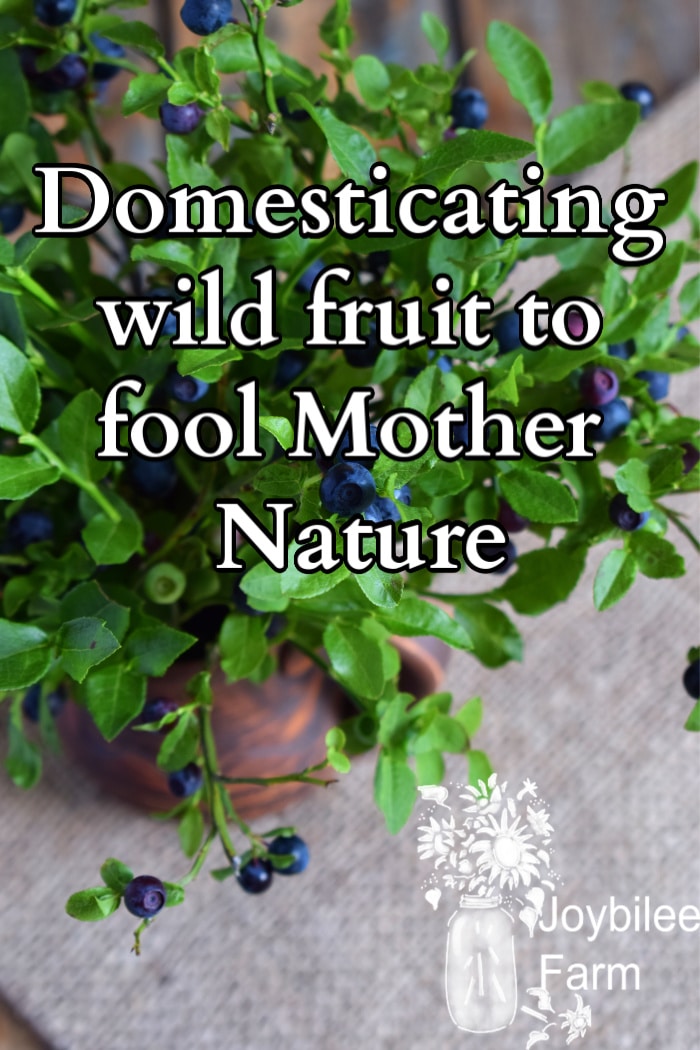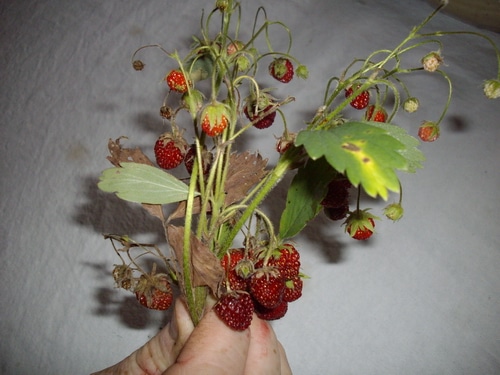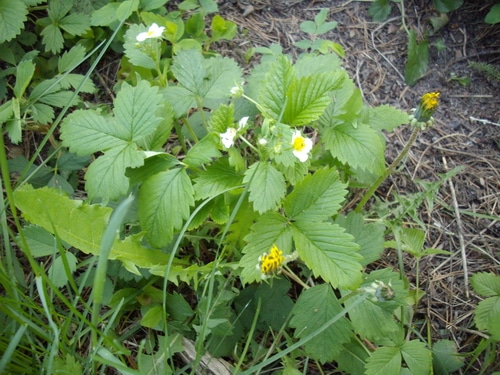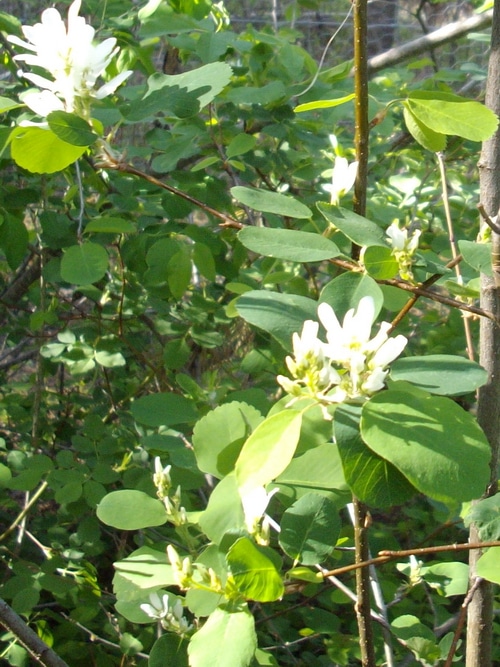If you are gardening in a harsh climate, take advantage of your local wild fruits and add them to your garden or permaculture garden for seasonal abundance, and effective harvests. Wild fruit plants are an effective way to add fruit to your garden, while increasing biodiversity and supporting your immediate ecosystem.

When homestead gardening in a harsh climate, you need to baby most domestic crops along. When you can get snow or frost any day of the year, peaches and grapes need tender loving care. Even apples are a hit and miss crop, and only hardy cultivars will survive long enough to produce a crop. 8 years ago, I had 25 ‘hardy’ apple cultivars professionally grafted onto extremely hardy dwarf root stock. It was such an unusual request that I had to purchase a package of 50 root stock in order for the grafter to do my order. We planted all 25 grafted apples and the remaining rootstock in a dedicated orchard area at Joybilee Farm and expected our first harvest of apples last year. Only 10 of the 25 grafted trees made it this far. All the root stocks survived, but have never flowered. There has to be a better way to get fruit in an area like this.
Conventional advice is the look at what grows wild in your area and plant domesticated varieties of these same plants. This assumes that domestic varieties of wild plants will thrive in the same growing conditions as their native sisters. This is not always the case. Take domestic strawberries, for instance. Domestic strawberries produce larger fruit than wild strawberries, on sprawling plants. To grow large berries, soil fertility must be high and you need to water them regularly and at the same time keep mold and mildew minimal. However, our harvests of domestic strawberries tend to frost and mildew, due to our cold mountain nights. Not so wild strawberries. The wild fruit is much smaller but it will grow without irrigation, and in fact grows in areas where soil is poor, and still flowers and fruits, even with cold nights. Further, the wild fruit needs no protection from frost, or snow, while the domestic fruit may need babying in the extreme areas of its growing zone. Wild fruit is also more flavourful, and sweeter than commercial fruit.
The problem with wild fruit, though, is that it can be small, seedy, and time consuming to pick. But bring the wild fruit home and give it a raised bed and regular watering and it responds to the extra care by producing larger, juicier fruit. Put it where you can reach it easily and the picking become less time consuming as well. By applying good gardening techniques to wild fruit you can gain hardy plants that thrive in your particular climate zone and will give you juicier, larger fruit than their more refined sisters.
With a little attention on your part, to match the growing conditions that favour the wild plant, you can have free cultivars for your garden. If you find a plant in full sun, plant it in full sun. If you find it growing in dappled sun, on the edge of the forest, plant it in dappled sun in your garden. If your soil is naturally acidic, don’t amend the growing bed with lime or ashes — keep it acidic. By matching the growing conditions of the wild plant, you will assure success, and gain larger, and easier to pick fruit for your troubles.

Growing Wild strawberries:
Called woodland strawberry, alpine strawberry, and european strawberry, wild strawberries are perhaps the easiest wild fruit to domesticate. Wild strawberries were grown in Europe for centuries in gardens and monastaries, before domesticated strawberries. While the wild plants send out ample runners and produce only a few tiny but sweet berries per plant, manage them like domestic strawberries and you will benefit.
Pick strawberry plants from several areas in the wild. Don’t take them all from the same area, and this will ensure genetic diversity. Transplant young plants into a raised bed. A hugelcultur bed is the perfect environment for strawberries. The beds are uniformly moist and fertile over several growing seasons, which both conserves water and minimizes spoilage from molds and mildew. The raised bed also makes harvesting easier.
Plant them on 12 inch circles in your raised bed. Mulch with straw to keep uniformly moist. Plant will produce berries over a long season. When the plant begins to runner, remove the runners so that the plant will put its energy into fruit production. Once fruiting has stopped you can allow the plant to runner to form new plants. 3 or 4 dozen plants will keep your family in berries for the summer. Wild strawberries can also be put in planters to good effect, but must be kept well-watered.
Plants are productive for 3 years and then you will need to replace them with fresh plants or divide the plants that you have. While the strawberries are still smaller than domestic berries and take a long time to pick, the flavour, health benefits, and gourmet quality is worth the effort, especially if you struggle in your climate to produce domestic strawberries.

For more information about wild strawberries:
Alpine Strawberries
Growing Saskatoons
The first time I tasted a Saskatoon in on my homestead, I spit it out. Mealy and tart, it took several years before I tried them again, this time in a jar of homemade jam, a gift from my friend. The taste was honey-sweet and delicious. I started harvesting the wild berries growing on our 140 acres and racing to get enough for a batch of jam before the black bears, robins, and waxwings stole the crop. My berries were still mealy when raw but cooked up into delicious desserts, jams, and jellies. However, give them a bit of water and a mildly fertile soil and they respond with larger, juicier berries.
Unlike strawberries who have both a wild and a cultivated variety, most cultivated saskatoons are wild plants that have been domesticated. By bringing wild Saskatoon plants into your garden and giving them the environment that they thrive in you will get bigger, juicier fruit.
Like strawberries and blueberries, Saskatoons prefer slightly acidic soil. Planting them in areas where pine trees grow will ensure the correct soil pH. When gathering material to propagate saskatoons choose from several plants growing in your area. Saskatoons can be cultivated by cuttings, or seeds. Or just transplant young, wild, plants.
Plants should be spaces 3 to 6 feet apart, where they will form a solid hedge. In the first year, control weeds around the young plants to allow them to become established.
Saskatoon plants begin to bear fruit when they are 2 to 4 years old. The fruit is produced on the previous years growth and on older wood. Usually young, vigorous branches yield the highest quality fruit. Pruning should be done in early spring after the danger of severe cold weather is past and before the plants start to grow. Removal of all weak, diseased, damaged and low branches as well as thinning of the centre growth to keep it open is recommended. Generally, major pruning is not required until the plants are 6 to 8 years old. US Gardener
Yields range from 1 to 8 kg. of fruit per plant after the 4th year. So 10 Saskatoon plants should keep a family in saskatoons for a year. The fruit can be used in jams, jellies, baking, making fruit leather, or dried berries. Prices for fresh saskatoons at the farmer’s market are $6 to $8 per kg. It will take 6 years for your bushes to come into full production. (Makes me wish I started this project when we moved here 8 years ago.) I’m going to do this, this spring.
Find out more about growing Saskatoons
Growing wild blueberries
Domesticated high bush blueberries grow very well in the Fraser Valley area of B.C., with its naturally acidic soil, ample rain, and mild climate that doesn’t damage the winter buds. Try to move these plants to colder areas though, and you’ll find that the plants get weaker and weaker every year, until they finally die completely. At the same time, wild, low bush blueberries sprawl close to the ground in colder areas of BC, in the same places that Kinnikinnic grows. Wild blueberries will take over recently logged areas or burned areas and are a favourite of the black bear, so watch for bears, if you are harvesting in the wild.
Bring them home and domesticate them by planting their seed, in raised beds, in full sun, where you want them to grow. Expect it to take 2 years for your blueberries to become established. Then you can harvest these tiny, but rich tasting and healthy fruit. Look for black currants in the same areas as wild blueberries, and add them to your wild fruit domestication.
Propagating wild blueberries from seed:
1. Take berries from multiple wild blueberry plants to ensure good cross-pollination in the field. Freeze 3/4 cup of wild blueberries for at least 90 days.
2. In a blender place thawed blueberries, 3/4 cup water, and blend for 10 seconds. Allow seeds to sink to the bottom and skim off the pulp that will rise to the surface. Repeat process until most of the pulp is skimmed and the seeds have sunk to the bottom. Drain the seeds and dry on a paper towel.
3. Place seeds in a 2 inch pots of sphagnum moss. And germinate. Transplant into prepared ground the following spring, in slightly acidic soil, and cover with straw mulch. Plants should be planted on 18 inch centers.
4. Plants will begin to bear in the following year after planting out.
Yields on true low bush blueberries is about 1 kg. of berries per plant. 10 to 20 plants will yield enough fruit for a family.
Plants yield fruit on the previous years growth. Old growth should be pruned out to encourage new growth. Commercial operations burn out the plants every two years and renew the plants, in order to crop them the following year. As a homesteader you can simply prune out older branches, encouraging fruiting on the one year old branches.
Here’s more information about growing wild blueberries.
Growing wild blueberries on the prairies.
Making acid soil for blueberries
Almost any wild berry can be successfully domesticated, except huckleberry. If you’ve had success with huckleberry, let me know because I’ve been trying for years to get it to grow where I want it to, instead of having to go where it wants to grow, to harvest it.
Another useful wild fruit shrub to domesticate is elderberry, check out the many benefits of elderberries here.
Back to you:
I’ve only scratched the surface on the potential for wild fruit on your homestead. What would you add to help others be successful in domesticating wild fruit on their homesteads? Leave a comment.



Dandellions are often used in salads. Some folks like it’s rucula like flavour.
Hummm… Saskatoons? Is there a cientific name for them? Here in the old Europe i have never heard of it, but maybe with the science backing me up i may take a hold of what it is, how they like to be grown and if there’s interestet in such, i even may apply for some sapplings to put on the ground, back at my own place…
We have some wild blackberries growing here that I would like to try this with! Thanks for the info =)
Excellent tip, Kristina. Thanks for mentioning that.
Dandelions (don’t laugh; I see them in vegetable seed catalogs all the time!), huckleberries – really any berry, fruit, or nut that grows wild in your area), cattails (if you have a wet area), wild onions, ramps, wild asparagus, purslane, miner’s lettuce, wild rose. Be sure to plant the wild transplant in an area that’s as close to it’s wild counterpart as possible. For example, if you find it growing in the shade, plant it in the shade. If it’s growing in heavy clay, plant it in heavy soil, and so on.